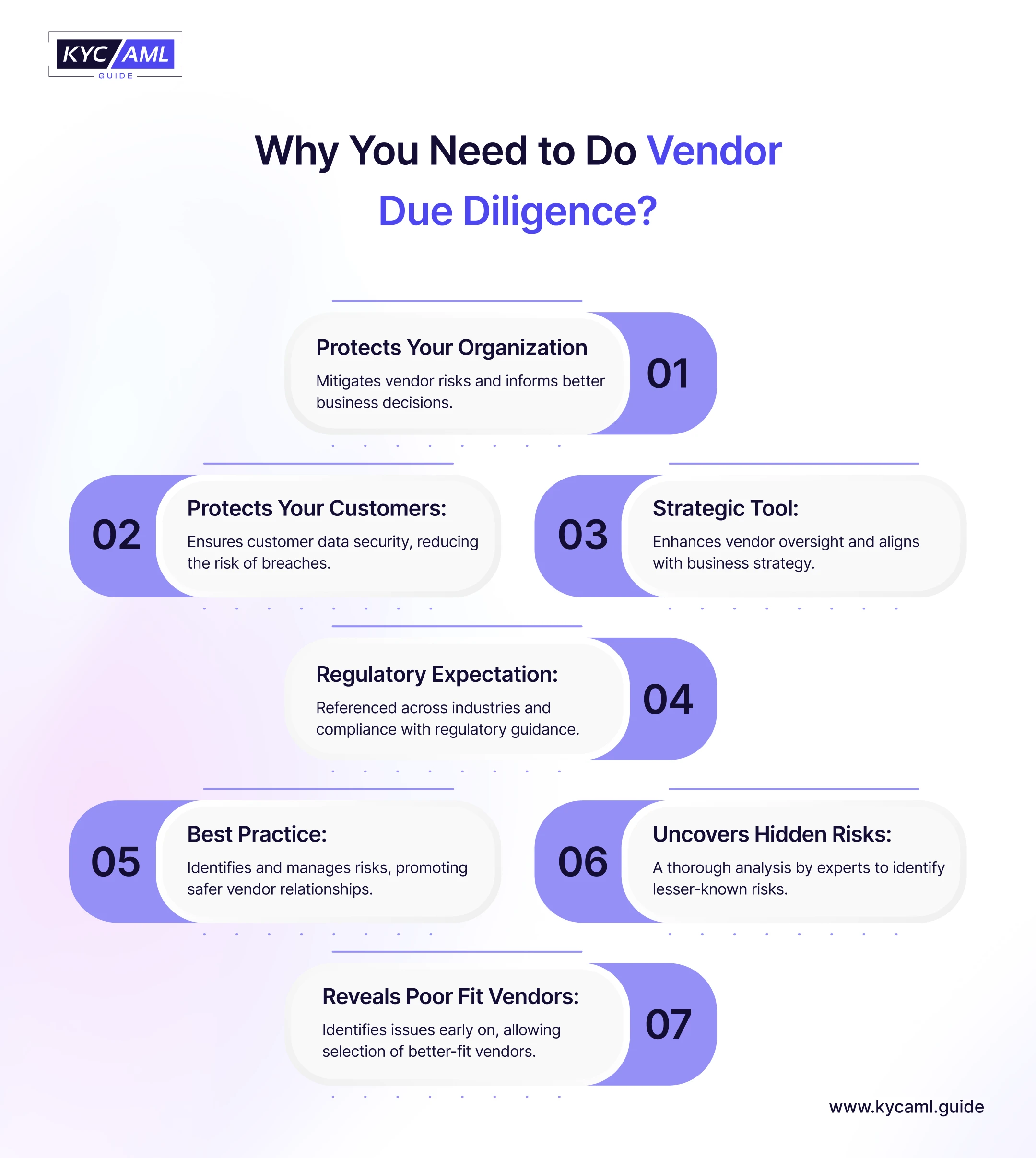Vendor Due Diligence (VDD)
The process of evaluating a vendor’s operational, legal, financial, and regulatory risks before forming a business partnership is known as vendor due diligence or VDD. In the same way, customer due diligence (CDD) assists financial organizations in verifying the authenticity of their customers’ identities and assessing the potential risk of money laundering associated with them. Because of their line of work and potential for financial crime, vendors must also take care to provide accurate information about the company. The ability to choose vendors based on risk is made possible by an efficient vendor due diligence procedure. It can expedite the onboarding of vendors and lower the likelihood of a significant infraction, dangers to third parties, or data breaches.
Vendors Due diligence should be done in two different ways:
Initial Vendor Due Diligence
This is a pre-signature background check on a vendor. It’s critical to assess the vendor and determine the hazards to which your business may be exposed. Determining whether the vendor fits your aims and budget will also be aided by a comprehensive study of the provider.
Ongoing Vendor Due Diligence
It’s crucial to carry out your due investigation even after the contract is signed. This helps identify changes in the vendor’s risks and maintains the document up to date. All vendors should undergo ongoing due diligence, but the frequency should be higher for high-risk vendors. The frequency may increase for other reasons, such as performance issues or better standards. Good vendor due diligence can help your company strengthen vendor relationships and be aware of new or emerging risks.
Approaches to Vendor Due Diligence
Your vendor due diligence process with each vendor will depend on the nature of your vendor relationships.
| In-house vendor | Outsourced third-party vendors | Shared vendor due diligence |
| The DIY Approach.
Many companies are trying to manage vendor data collection and internal research. And even if your company is well-staffed and funded, in-house VDD can be a burden if you’re using manual tools for process management. Third-party automated risk management platforms can help you with in-house vendor due diligence. |
The Managed Services Approach
It is a good choice for groups with limited resources or limited access A third party is outsourced to collect evidence and for vendor risk assessment. This approach frees your in-house team to focus on risk identification and remediation, rather than chasing down feedback and verifying their accuracy. This method can reduce risks more quickly. |
The Network Approach
Companies may share the due diligence process with third parties and between them. Vendor risk intelligence networks help companies collaborate with third parties to facilitate risk analysis and reduce risk. |
What is the Vendor Due Diligence Process?
This procedure aims to examine and assess the target company’s financial and legal circumstances as well as the dangers that the business faces. The steps in the vendor due diligence procedure are as follows:
1 Hire a Third Party:
To carry out a comprehensive audit, the vendor (target company) employs a third party. To perform the inquiry, the third party needs to be competent, unbiased, and independent.
2 Contact Third Parties:
The vendor contacts third parties such as maintenance providers to ensure that necessary steps have been taken before the sale. This step is very important because it helps to control the risk of money laundering.
3 Preparation of Vendor Due Diligence Report:
The vendor due diligence reports are prepared based on the inspection and sent to all prospective buyers or partners for inspection. This report allows buyers to do their due diligence.
4 Negotiation:
Prospective purchasers and sellers might work out a deal based on the offer.
5 Completion of the Sale:
Following the sale, the buyer gets the vendor’s due diligence report, which includes details about the company’s legal and financial standing as well as any transaction-related risks.
Accurate vendor information must be gathered to lower risks and guarantee the success of business dealings. Check out our Vendor Due Diligence Checklist as well for help in accurately assessing your vendors.
Why is Vendor Due Diligence Important?
Businesses employ VDD as a strategic tool to guarantee informed choices and lower the risks connected to dealing with third parties. This comprehensive system has many advantages:

Risk Management:
The most important part of VDD is based on its ability to identify and analyze risks, protecting the company from possible financial losses, legal problems, and damage to its reputation. By carefully evaluating vendors, companies can avoid the pitfalls of dealing with illegal or fraudulent companies.
Regulatory Compliance:
Compliance with laws and regulations is inevitable, especially in finance, health, and safety. VDD plays an important role in ensuring that all other relationships meet these strict requirements, thereby maintaining legal and ethical standards.
Transaction Outcome:
A critical role of the VDD is to uncover any hidden costs or financial irregularities that may affect the value of the relationship or acquisition. A deep understanding of the vendor’s terms helps you better analyze the benefits and results of the transaction.
Operational Efficiency:
To be efficient, VDD simplifies the vendor selection process. It supports companies with the knowledge they need to quickly identify and connect with key partners, thereby increasing operational efficiency.
Build Trust and Transparency:
Trust is the foundation of any successful business relationship. VDD strengthens this trust by providing a clear, objective, and comprehensive assessment of vendors’ performance, key performance indicators, and compliance standards.
VDD and AML compliance
In identifying and reducing the risks connected to money laundering and financing of terrorism, the VDD is crucial. Investors are reassured by VDD, that the broker has sufficient AML policies, procedures, and controls to stop and identify money laundering, terrorism financing, and other illicit activity. The AML VDD process generally assesses the implementation and effectiveness of the vendor through
- AML Compliance Program
- Customer Due Diligence (CDD)
- Enhanced due diligence (EDD).
- AML systems and technology
- Research and testing process
- AML training
VDD experts also review the vendors’s history of regulatory investigations, enforcement actions, and sanctions related to AML non-compliance, including reviewing audit reports, contractual agreements, and other regulatory documents to identify areas of concern. Vendor AML compliance is a priority for money services businesses (MSBs) such as banks, exchanges, FinTech companies, and other companies that operate under strict AML regulations.
Difference between Vendor Due Diligence and Customer Due Diligence
| Vendor Due Diligence | Customer Due Diligence |
| This crucial procedure aids businesses in recognizing, comprehending, and reducing dangers associated with their dealings with vendors and service providers. | Risk assessment, compliance assurance, and client or partner identification verification are prioritized. |
| Buyers conduct VDD to evaluate vendors before sales or partnerships. | The providing business conducts CDD during onboarding. |
| It relies on a Vendor due diligence checklist, questionnaires, and financial analysis. | It relies on Identity Verification tools. |
| Includes focus on financial issues, corporate structure, legal compliance, and ethical strength of vendors. | This is the process of understanding the client’s business model and its involvement in illegal activities. |
Bottom Line
Vendor due diligence ensures that the target companies are risk-free and compliant with KYC AML regulations. KYC AML guide provides Vendor Analysis consultancy to help you choose the best for your business. This not only helps buyers but also develops a better understanding of their vendors and also makes them aware of potential risks.





